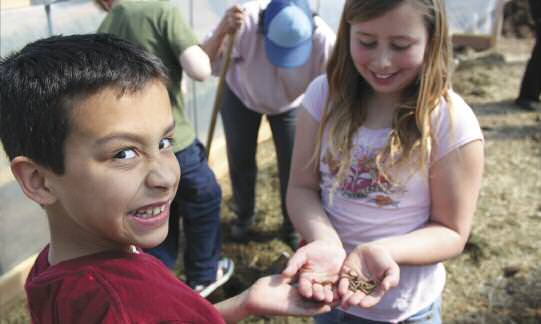edible garden
Josias Heredia and Bella Kordonowy at Dayton Elementary
ADMIRABLE AERATORS
Make beautiful compost with help from a few little friends.
WRITTEN BY SANDRA MACIAS
PHOTO BY NICHOLETTE CODDING AND JACI GOODMAN
Mention worms and most folks have one thing to say, “Ick.” But not gardeners. They don’t find earthworms icky, but admirable soil aerators.
Serious gardeners also respect another beneficial worm. Its proper name is eisenia foetida. But who can remember that? So call them by their common names: red wigglers, brandlings, or manure worms. Heather Kahabka, owner of Plant It Nursery in Gardnerville, describes them as “reddish to maroon in color, skinny, and as high-strung as my 6-year-old son.”
These worms are the superstars of a recent trend in organic gardening. Pint-sized at 2 to 4 inches, they are the power horses of vermiculture, the process of using worms to make compost.
THE WORMERY
Composting with worms begins in a bin, the worms’ home and known as “the wormery.” Here, the worms munch away, breaking down vegetable and fruit waste. What they leave behind is composted matter, also called vermicompost or worm castings.
Homemade or commercial, bins are made of wood, plastic, and even cinder block. Store-bought wormeries generally are plastic and available in different sizes and shapes. Handily mobile, they can move outside in a shady spot during summer and into the garage or laundry room in winter. (Worms don’t like extreme temperatures.) Shop for worm bins in local nurseries or online. (Google “worm composting bins” to research.)
A do-it-yourself wormery can be as simple as a wooden box. Another option is a plastic container, such as a tub, dustbin, or 1-gallon plastic nursery pot. The latter is what Kahabka will use for a vermiculture class, taking place on June 5, to demonstrate how to set up a small composting bin.
“It’s small enough to keep it under your sink,” she says.
OUTDOOR HOME
Reno Worm Farmer Darren Murphey, owner of Sierra Worm Solutions, prefers a permanent outdoor bin lined with cinder blocks.
“An indoor bin under the sink is great,” he says, “but I’m convinced an outdoor bin is the way to go.”
Murphey’s website (Sierrawormsolutions.com) has a video on how to build it. You also can view his Spanish Springs worm farm with a ribbon of bins, totaling 260 feet, stretching through the sagebrush. Under a blanket of snow or exposed to beating sun, the bins insulate well.
“The ground moderates the temperature and the worms are fine,” Murphey says.
BRING IN THE WORMS
So, you’ve settled on a bin. Next is to prepare it for the worms. Start with 1,000 worms, about 1 pound. They will reproduce rapidly within three to four months. (The worms can be purchased at nurseries or from Murphey.)
First, cover the bottom with moistened bedding (i.e., shredded newspaper, shredded dry leaves, decomposed garden compost, or manure). The worms are next, followed by a layer of veggie and fruit scraps. Cover the bin and let the worms get to work.
Their industrious labor results in composted matter, nutrient-rich, dark as tobacco and smelling like the forest earth after a rain. And oh, my, how gardening experts sing its praises.
“It’s organic and sustainable and has much more nutrients than fertilizer,” Kahabka says. “It is also a quicker way of composting than standard compost and it processes down completely. It’s one nice, rich product.”
“It is gardener’s gold,” says Marnie Brennan, garden coach at Garden Shop Nursery in Reno. Especially when used with backyard compost, she adds.
“Both work hand in hand recycling the food you eat back into the soil for new garden life. It’s a nice circle,” says Brennan, who hosts a weekly gardening radio program, Saturdays at 8 a.m., 1270 AM on the dial.
MULTIPLE USES
Vermicompost works as a soil enhancer, lawn conditioner, and mulch. Mixed with potting soil, it is great on houseplants and patio containers. Made into tea –– “worm tea” as Murphey calls it –– it becomes a healthy plant spray. (Murphey’s recipe is on his website.)
“My peach tree had white fungus all over its leaves,” Murphey says. “I sprayed the tree with the tea, and the fungus completely disappeared. Now I spray the tea on everything in our garden.”
WORM TIPS
There is a learning curve with beginning vermiculturists. The most common mistake is over-feeding the worms.
“That is the biggest killer in the worm bin,” Murphey says.
Soggy bin contents are another. Too much moisture and the worms drown.
“You have to keep an eye on them to see what they’re doing,” Kahabka says. “Remember, you are working with living things. You have to take care of them.”
But once you’ve got the hang of it, the worms will thrive –– and so will your garden, thanks to the worms’ and your efforts.
Sandra Macias is a Reno freelance writer, a seat-of-the-pants gardener who pampers her compost heap and vegetable garden in the summer. Vermiculture may be her next project –– if she can get over the “ick” factor. Meanwhile, thank heavens for nurseries and Darren Murphey who sell worm castings.


